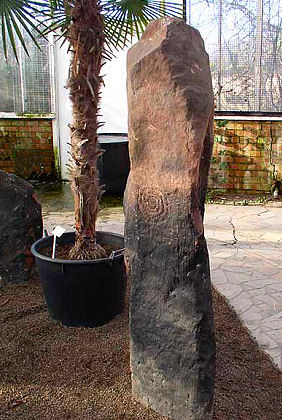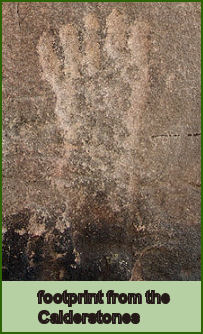Calderstones
OS Grid ref:- SJ405875
 The Calderstones are situated at Calderstones Park, Allerton, Liverpool. They are now enclosed in the Harthill Greenhouses in the park to protect them from the elements.
The Calderstones are situated at Calderstones Park, Allerton, Liverpool. They are now enclosed in the Harthill Greenhouses in the park to protect them from the elements.
 The stones were once part of a chambered tomb, known as a passage grave and are lavishly decorated with many rock art symbols including spirals, concentric circles, arcs, cupmarks, cup and ring marks and footprints and are thought to date from the late Neolithic/ Bronze Age.
The stones were once part of a chambered tomb, known as a passage grave and are lavishly decorated with many rock art symbols including spirals, concentric circles, arcs, cupmarks, cup and ring marks and footprints and are thought to date from the late Neolithic/ Bronze Age.
Carved stones from this period are rare and very few survive, the stones that form the Calderstones monument arguably have the most elaborately carved decoration of all passage grave monuments in Britain.
The six surviving stones are composed of soft local sandstone and range in size from around eight feet (2.4 metres) to three feet (1 metre) high.
Very little is recorded about the history of the Calderstones until the 1800's when the site was broken up. It is recorded that, "...in digging about them, urns made of the coarsest clay, containing human dust and bones, have been discovered, there is reason to believe that they indicate an ancient burying- place. When a road was being widened they dug down into the mound they found more of the stones, and some were marked with spiral and cupmarks. It was reported that “When the stones were dug down to, they seemed rather tumbled about in the mound. They looked as if they had been a little hut or cellar. Below the stones was found a large quantity of burnt bones, white and in small pieces. He thought there must have been a cart-load or two".
In 1845 the stones were re-erected inside a low circular wall in a traffic island at the entrance to Calderstones Park opposite Druids Cross Road. They were moved to their present location in 1954 by the city council.
The greenhouses are kept locked and permission to view the stones should be requested from the Park Rangers in advance.
